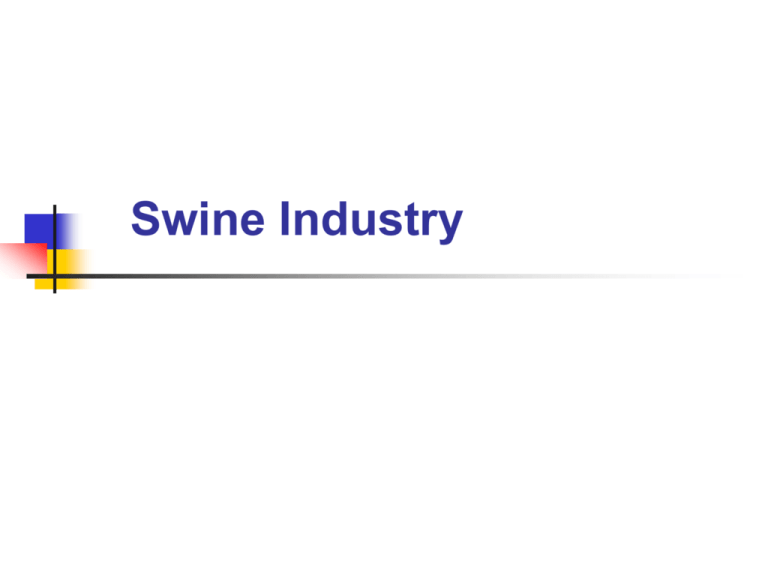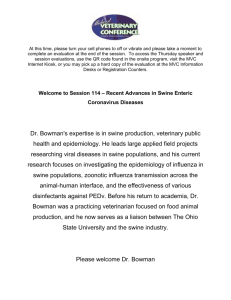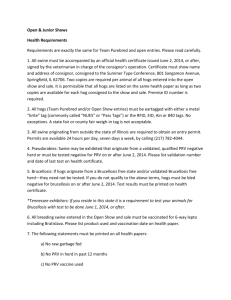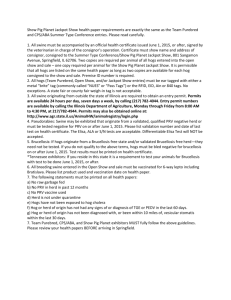Swine Industry
advertisement

Swine Industry Swine Facts Swine are popular because of their meat - pork. They reproduce at a high rate, grow fast, require low amounts of labor, and give a fast return on investment. Pork is referred to as: the other white meat. Swine Facts Swine were first domesticated in Asia about 9,000 B.C. Swine were brought to America by Christopher Columbus in 1493. These swine were not wild, but of European and Asian breeding. Scientific Name - Sus scrofa domestica. Swine Industry 3/4 of the hogs produced in the U.S. are produced in the Corn Belt. When corn yields are high, corn prices are low and hog production increases. Swine Industry More than 60% of the hogs in the U.S. are grown in confinement buildings. Many of these are produced under contract with a processing company. Swine Industry Hogs are the second largest livestock population in the U.S., with nearly 70 million head. Iowa, Illinois, and Indiana are the leading states. North Carolina sharply increased production in recent years. Favorable Factors Efficient in converting feed to meat. Less than 5 pounds of feed for 1 pound of pork. 9 pounds are needed for beef. Favorable Factors Swine are very prolific. Meaning they will produce a large number of young. Sows will farrow 7 to 12 piglets twice a year. Gestation is 114 days. Favorable Factors Swine excel in dressing percentage. They will yield 65-80% of their live weight. Cattle dress out at 50-60%. Favorable Factors Labor requirements are lower: hogs are good at self-feeding. Capital investments are generally low, with return to investments relatively short. Unfavorable Factors Hogs are susceptible to disease and parasites. Hogs must be fed a large amount of concentrates and minimal forages due to the simple stomach (monogastric). Unfavorable Factors Require special attention at farrowing. Disposal of waste is an issue. Corporate Swine Production More swine are being grown in large, factory farm systems and less as family-operated farms. Producers may be under contract with a company that provides the piglets, monitors production, supplies feed, and markets the hogs. (vertical integration) Corporate Swine Production During growth careful attention is given to nutrition and disease control. People are not allowed in facilities where the hogs are growing. Producers enter only after bathing and wearing carefully laundered clothing. Classification of Swine Piglet Barrow Mature female Gilt Castrated male Sow Young swine Young female Boar Male hog High-Quality Meat Hogs Barrows and gilts are used for high-quality meat. Sows and boars may be made into sausage or cooked food products. Meat-Type Hogs Swine are produced for meat. People want lean meat without much fat. Meat-Type Hogs give the greatest amount of lean meat in high-value cuts, such as the ham. Meat-Type Hogs Meat-Type Hogs Need to grow fast and efficiently. Need plenty of muscle tissue (meat). Long animal, with deep, welldeveloped muscles in the hams. Meat-Type Hogs Major meat products: Ham Bacon Loin Cuts Roasts Production Systems Feeder Pig Production A feeder pig is about 40 pounds and has just been weaned. This system involves maintaining a herd of brood sows and having facilities for breeding and farrowing litters of pigs. Boars or AI may be used. Feeder pigs are sold to farms that feed them to market weight. Production Systems Finishing is feeding feeder pigs to market size. Ideal market hog weight is around 250 pounds. Many packers have specific weights. Prices may decline if producers don’t hit the ideal or target weight. Production Systems Farrow-to-Finish Pigs are farrowed and fed to market weight on the same farm. The producer has farrowing facilities and facilities for feeding out the pigs. Production Systems Purebred hog production is raising hogs that can be registered by the breed associations. All standards must be met. Goal - Breeding Stock.




